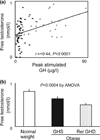The relationship between reduced testosterone, stimulated growth hormone secretion and increased carotid intima-media thickness in obese men
- PMID: 20681993
- PMCID: PMC3225917
- DOI: 10.1111/j.1365-2265.2010.03859.x
The relationship between reduced testosterone, stimulated growth hormone secretion and increased carotid intima-media thickness in obese men
Abstract
Objective: Obesity is associated with reduced testosterone and growth hormone (GH). However, the interrelationship between these axes and their independent contributions to cardiovascular risk is unknown. The objectives of this study were to determine (1) the association between testosterone and GH in obesity, (2) whether excess adiposity mediates this association and (3) the relative contribution of reduced testosterone and GH to increased carotid intima-media thickness (cIMT) in obesity.
Design: Fifty obese men were studied with GH-releasing hormone-arginine testing, and morning free testosterone (FT) was measured by equilibrium dialysis. Metabolic, anthropometric and cardiovascular risk indices, including cIMT were measured. Twenty-six normal weight men served as controls.
Results: Obese subjects demonstrated lower mean (±SEM) peak stimulated GH (5·9 ± 0·6 vs 36·4 ± 3·9 μg/l; P < 0·0001) and FT (0·41 ± 0·03 vs 0·56 ± 0·03 nmol/l; P = 0·0005) compared to controls. GH was significantly associated with FT (r = +0·44; P < 0·0001) and both were inversely related to visceral adipose tissue (VAT) (GH: r = -0·65; P < 0·0001; FT: r = -0·51; P < 0·0001). In multivariate regression analysis controlling for VAT, FT was no longer related to GH. Both GH and FT were associated with cIMT in univariate analysis. However, in multivariate modelling including traditional cardiovascular risk markers, GH (β = 0·003; P = 0·04) but not FT (P = 0·35) was associated with cIMT.
Conclusions: These results demonstrate a strong relationship between FT and GH in obesity and suggest that this relationship is more a function of excess adiposity rather than a direct relationship. While reduced FT and GH are both related to increased cIMT, the relationship with reduced GH remains significant controlling for reduced FT and traditional cardiovascular disease risk markers.
Trial registration: ClinicalTrials.gov NCT00562796.
© 2010 Blackwell Publishing Ltd.
Figures


Similar articles
-
Discordance of IGF-1 and GH stimulation testing for altered GH secretion in obesity.Growth Horm IGF Res. 2014 Feb;24(1):10-5. doi: 10.1016/j.ghir.2013.11.001. Epub 2013 Nov 15. Growth Horm IGF Res. 2014. PMID: 24291224 Free PMC article.
-
Reduced growth hormone secretion is associated with increased carotid intima-media thickness in obesity.J Clin Endocrinol Metab. 2009 Dec;94(12):5131-8. doi: 10.1210/jc.2009-1295. Epub 2009 Oct 16. J Clin Endocrinol Metab. 2009. PMID: 19837914 Free PMC article.
-
Cardiac mass and function, carotid artery intima-media thickness, and lipoprotein levels in growth hormone-deficient adolescents.J Clin Endocrinol Metab. 2001 Mar;86(3):1061-5. doi: 10.1210/jcem.86.3.7268. J Clin Endocrinol Metab. 2001. PMID: 11238486
-
Carotid intima-media thickness: knowledge and application to everyday practice.Postgrad Med. 2010 Jan;122(1):10-8. doi: 10.3810/pgm.2010.01.2091. Postgrad Med. 2010. PMID: 20107284 Review.
-
New advances in noninvasive imaging of the carotid artery: CIMT, contrast-enhanced ultrasound, and vasa vasorum.Curr Cardiol Rep. 2010 Nov;12(6):497-502. doi: 10.1007/s11886-010-0139-0. Curr Cardiol Rep. 2010. PMID: 20799001 Review.
Cited by
-
Testosterone and cardiac mass and function in men with type 1 diabetes in the Epidemiology of Diabetes Interventions and Complications Study (EDIC).Clin Endocrinol (Oxf). 2016 May;84(5):693-9. doi: 10.1111/cen.12990. Epub 2016 Jan 25. Clin Endocrinol (Oxf). 2016. PMID: 26641212 Free PMC article. Clinical Trial.
References
-
- Iranmanesh A, Lizarralde G, Veldhuis JD. Age and relative adiposity are specific negative determinants of the frequency and amplitude of growth hormone (GH) secretory bursts and the half-life of endogenous GH in healthy men. Journal of Clinical Endocrinology & Metabolism. 1991;73:1081–1088. - PubMed
-
- Riedel M, Hoeft B, Blum WF, et al. Pulsatile growth hormone secretion in normal-weight and obese men: differential metabolic regulation during energy restriction. Metabolism. 1995;44:605–610. - PubMed
-
- Van Dam EW, Roelfsema F, Helmerhorst FH, et al. Low amplitude and disorderly spontaneous growth hormone release in obese women with or without polycystic ovary syndrome. Journal of Clinical Endocrinology & Metabolism. 2002;87:4225–4230. - PubMed
-
- Bonert VS, Elashoff JD, Barnett P, et al. Body mass index determines evoked growth hormone (GH) responsiveness in normal healthy male subjects: diagnostic caveat for adult GH deficiency. Journal of Clinical Endocrinology & Metabolism. 2004;89:3397–3401. - PubMed
Publication types
MeSH terms
Substances
Associated data
Grants and funding
LinkOut - more resources
Full Text Sources
Other Literature Sources
Medical

